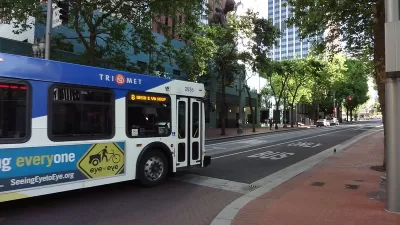Orange County provides the latest development in the ongoing experiment with transit in Southern California, hoping that a high-frequency bus grid can reverse slumping ridership numbers.
Meghan McCarty reports on recent developments in the bus transit planning arena in Orange County, California.
According to McCarty, "Orange County has seen among the biggest drops in ridership within the region, recording about a 30 percent decrease since 2008." (Similar news about declining transit ridership recently focused on Los Angeles, but Orange County is faced with similar trends. Be sure to read the comments of the earlier story for commentary on the data used to create the story.)
Earlier in November, however, the Orange County Transportation Authority (OCTA) proposed an overhaul of the system based on the Houston examples of "increasing frequency for popular lines while reducing or cutting others altogether," as McCarty wrote at the time of the proposal's release to the public.
Fast forward to February, and OCTA officials have revised the November proposal due to public outcry. Here McCarty describes the changes made to the original plan: "In response to the public outcry, officials have proposed a new plan that restores service to 14 lines that would have been cut. But to keep the budget on track, the plan also scales back some of the increases in service proposed for other lines."
FULL STORY: Updated Orange County bus plan proposed after public outcry over cuts

Manufactured Crisis: Losing the Nation’s Largest Source of Unsubsidized Affordable Housing
Manufactured housing communities have long been an affordable housing option for millions of people living in the U.S., but that affordability is disappearing rapidly. How did we get here?

Americans May Be Stuck — But Why?
Americans are moving a lot less than they once did, and that is a problem. While Yoni Applebaum, in his highly-publicized article Stuck, gets the reasons badly wrong, it's still important to ask: why are we moving so much less than before?

Using Old Oil and Gas Wells for Green Energy Storage
Penn State researchers have found that repurposing abandoned oil and gas wells for geothermal-assisted compressed-air energy storage can boost efficiency, reduce environmental risks, and support clean energy and job transitions.

Greening Oakland’s School Grounds
With help from community partners like the Trust for Public Land, Oakland Unified School District is turning barren, asphalt-covered schoolyards into vibrant, green spaces that support outdoor learning, play, and student well-being.

California Governor Suspends CEQA Reviews for Utilities in Fire Areas
Utility restoration efforts in areas affected by the January wildfires in Los Angeles will be exempt from environmental regulations to speed up the rebuilding of essential infrastructure.

Native American Communities Prepare to Lead on Environmental Stewardship
In the face of federal threats to public lands and conservation efforts, indigenous groups continue to model nature-centered conservation efforts.
Urban Design for Planners 1: Software Tools
This six-course series explores essential urban design concepts using open source software and equips planners with the tools they need to participate fully in the urban design process.
Planning for Universal Design
Learn the tools for implementing Universal Design in planning regulations.
Heyer Gruel & Associates PA
City of Moreno Valley
Institute for Housing and Urban Development Studies (IHS)
City of Grandview
Harvard GSD Executive Education
Salt Lake City
NYU Wagner Graduate School of Public Service
City of Cambridge, Maryland



























